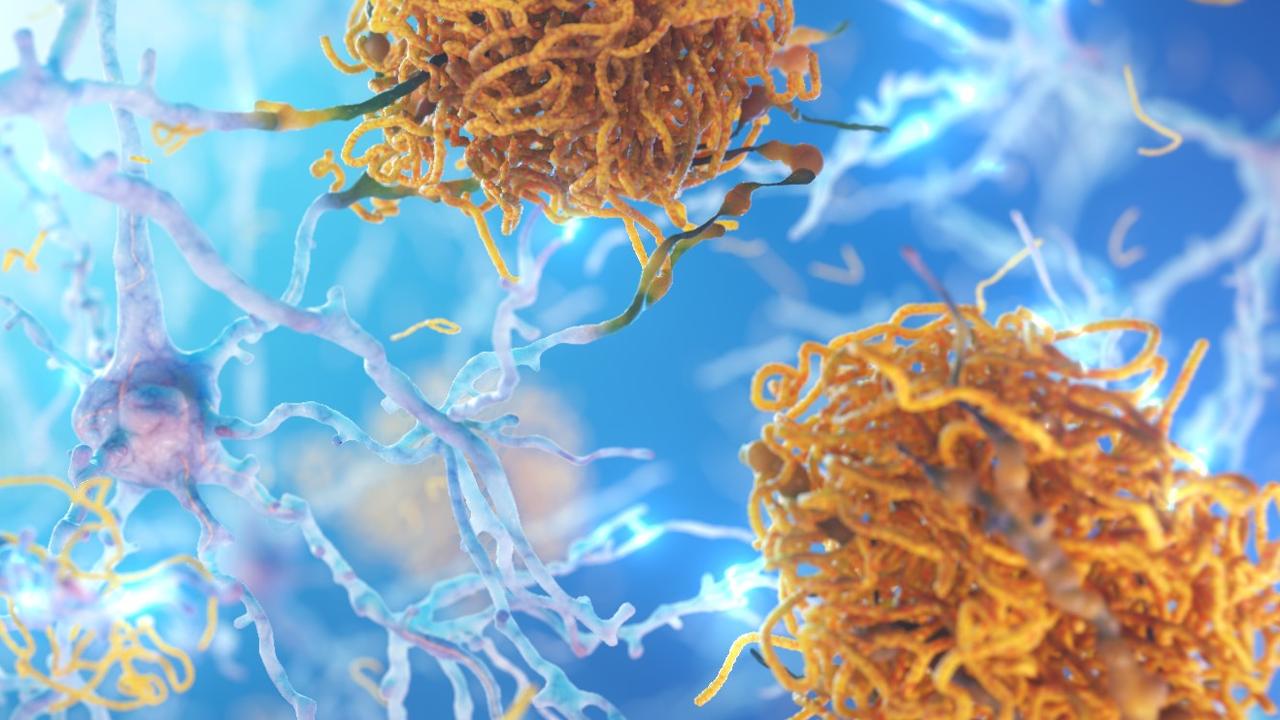Training Dexter: How blood spatter experts learn their trade in a room filled with horse blood
BLOOD dripping down the walls, a victim slumped on the floor. Just another day at the office for these guys. Warning: Graphic
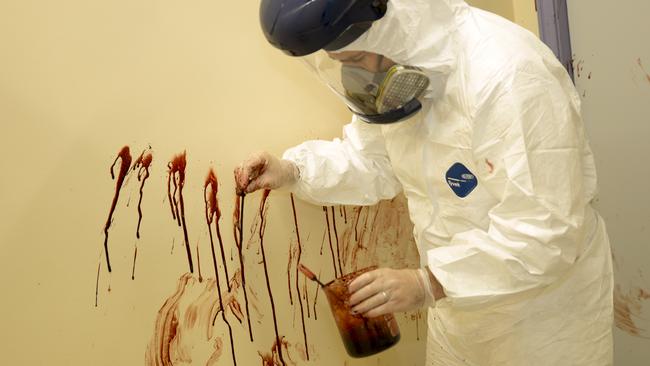
WARNING: Graphic images.
“FIRE in the hole!,” yells bloodstain pattern analyst Shawn Harkins from inside the family room of an ordinary-looking suburban weatherboard house. The three of us standing outside the front door take another, slightly alarmed step backwards.
Yellow and black plastic tape swings just above waist height across entry points to the building. It reads: “CRIME SCENE DO NOT CROSS.”
Mr Harkins is wearing white zip-up coveralls with a hood, disposable feet coverings, rubber gloves and a splash shield to protect his face. The negative pressure respirator makes his breath sound deep, loud and eerie.
He raises a metal mallet into the air and then, just to be certain we are out of the way bellows: “All clear?”
“All clear!” replies forensics technical officer Genevieve Williams with equal gusto.
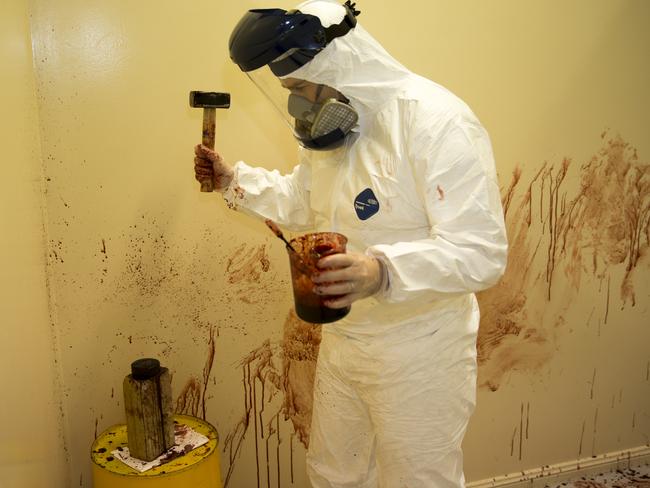
With reasonable force Mr Harkins smacks the mallet down onto a rubber hockey puck, sending a fine shower of sterilised horse blood across the pale yellow walls.
This is Canberra Institute of Technology’s (CIT) Crime Scene House, located in the city’s northern suburb of Bruce. Mr Harkins, who has been working in the field of forensic investigation for 15 years, is setting up an exam for students undertaking a Bachelor of Forensic Science.
Both civilians and law enforcement professionals come to this facility — from across Australia and the world — to learn how to investigate a realistic crime scene.
After much trial and error with different objects, Mr Harkins says CIT staff developed the hockey puck technique to consistently emulate “impact spatter patterns.”
“The more force that is applied to a source of liquid blood, the smaller the blood droplets become. They leave a distinctive pattern on the wall.
“If it’s interpreted correctly and in conjunction with some mathematics, some trigonometry, we can determine where the person’s head was at the time that they were struck in three-dimensional space,” Mr Harkins explains.
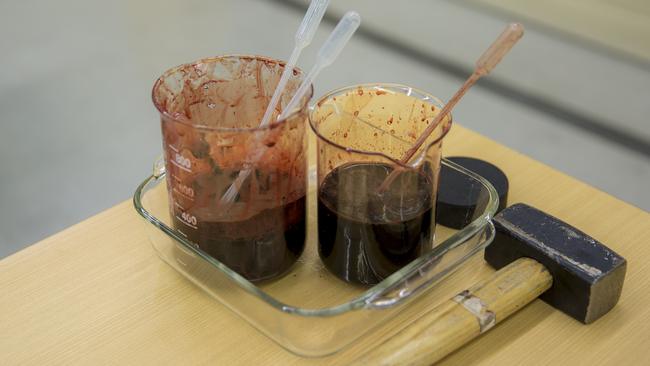
This evening Mr Harkins is carefully creating the blood spatter patterns of a fictional homicide in which the victim was struck several times against the wall.
Each scenario takes him about 25 minutes to set up. He starts the process with a beaker of horse blood in his hand and, using a pipette, carefully drips it across the floor and onto a pile of clean, folded laundry sitting on the coffee table.

In order to be interpreted by an investigator, Mr Harkins repeatedly emphasises that a crime scene must have a clear “sequence to it,” and the best way to create this is by behaving like the injured victim.
“I need to be the person who is bleeding and deposit those blood stains as a person would moving through a house,” Mr Harkins says.
After carefully smearing sterilised horse blood down the walls with his hand, Mr Harkins lies down on the floor and rolls in yet more blood. Acknowledging this might be an odd sight, he calls out: “It really is an unusual job I’ve got sometimes!”
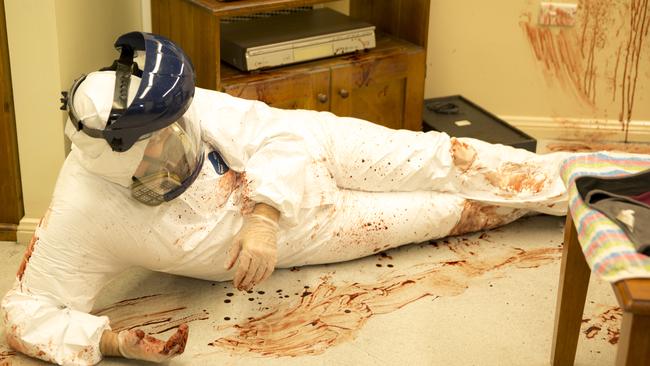
A female dummy with red stains on her nightie is laid on the floor in front of the TV with a pool of blood around her head. Mr Harkins leaves the room and peels off his facial coverings and bloodied gloves.
Mr Harkins acknowledges the room is a gory sight.
“As a crime scene investigator you can never escape fully, the human tragedy or the sheer overwhelming image that a crime scene may present you with.”
However he says it is possible to “choose the right people to do the job and to educate them on the pitfalls of going to these confronting scenes.”
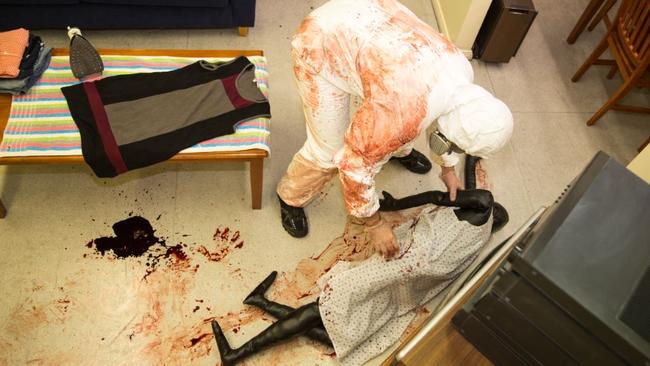
As someone who is accustomed to teaching others to see logic among the chaos, he points me towards the blood trail.
“The homicide starts at the front door and a series of round circular bloodstains indicate that somebody is bleeding from an injury and they’re mobile,” he says.
The drip trail “leads across to the telephone,” Mr Harkins continues, and “there’s blood on the telephone and 000 has been pressed and the 0 on the telephone has actually got some contact transfer staining with blood as well.”

According to Mr Harkins, the mix of blood spatter patterns in the room is key to understanding how the homicide unfolded.
“Where we see a spattered pattern that’s been wiped through afterwards, it indicates that the spatter has occurred first, of course, and then the wipe or contact second.
“In combination with other blood stain patterns, we may be able to paint an entire picture of what happened without ever being told any information from witnesses,” he says.
The next morning we’re back at CIT’s Crime Scene House again and a handful of students wearing blue hooded coveralls, masks, goggles and gloves are hard at work inside with plastic numerical markers, rulers and digital SLR cameras.
Cath, a mature-age student in the second year of her Bachelor of Forensic Science degree, is “fascinated” by the process but says today is just the “starting phase” of the investigation.
“You might formulate some ideas, but you make absolutely no determinations until you’ve collected all your data and then you’ve processed all the data and you see what the data tells you,” she says.
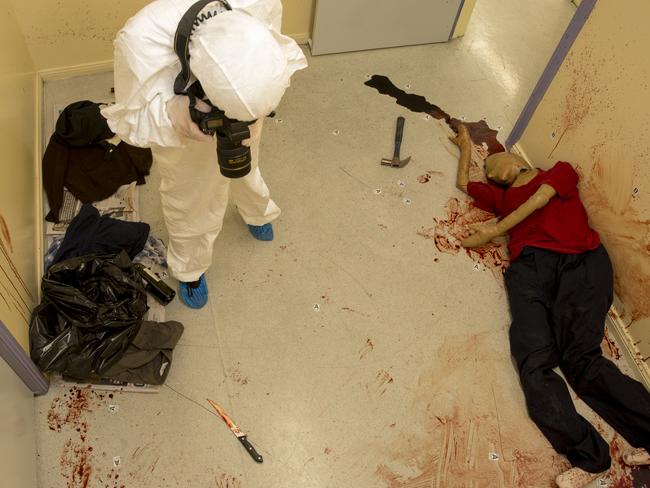
Mr Harkins says the students will have a have a month to write a court report just like one that might be used as evidence in a real-life court case or coronial inquiry. The key difference, of course, is that this report must be based on the horse blood stains Mr Harkins deposited at the house 18 hours earlier.
The other difference is the students have to clean up the mess themselves.
“Blood is inherently difficult to clean up,” Mr Harkins says, “if our students are provided with the opportunity to clean that up, they’ll very quickly realise that discrete blood stains can be easily left behind.
“Even when somebody tries to hide evidence or tries to clean a crime scene, there will always be evidence left behind to find by a competent forensic investigator,” he says.
Ginger Gorman is a multi-award winning print and radio journalist, and a 2006 World Press Institute Fellow. Follow her on twitter: @freshchilli



